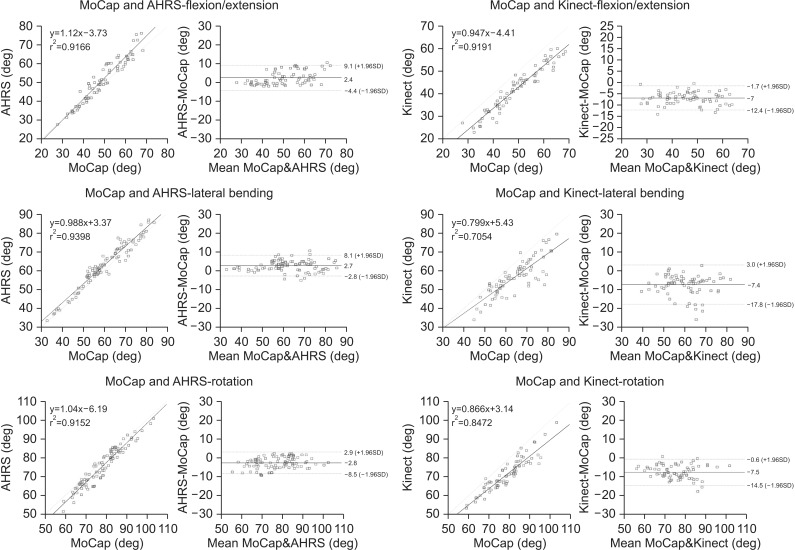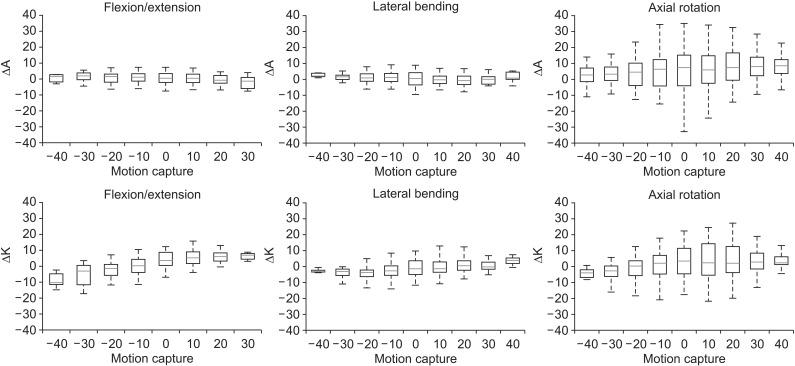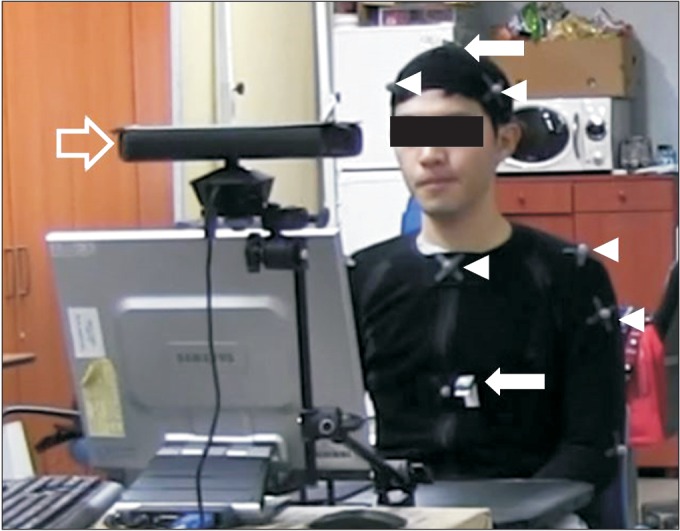1. Youdas JW, Carey JR, Garrett TR. Reliability of measurements of cervical spine range of motion: comparison of three methods. Phys Ther. 1991; 71:98–104. PMID:
1989013.
2. Cano SJ, Hobart JC, Fitzpatrick R, Bhatia K, Thompson AJ, Warner TT. Patient-based outcomes of cervical dystonia: a review of rating scales. Mov Disord. 2004; 19:1054–1059. PMID:
15372595.

3. Jost WH, Hefter H, Stenner A, Reichel G. Rating scales for cervical dystonia: a critical evaluation of tools for outcome assessment of botulinum toxin therapy. J Neural Transm (Vienna). 2013; 120:487–496. PMID:
22899277.

4. Mularski S, Picht T, Kuehn B, Kombos T, Brock M, Suess O. Real-time tracking of vertebral body movement with implantable reference microsensors. Comput Aided Surg. 2006; 11:137–146. PMID:
16829507.

5. Bifulco P, Cesarelli M, Romano M, Fratini A, Sansone M. Measurement of intervertebral cervical motion by means of dynamic x-ray image processing and data interpolation. Int J Biomed Imaging. 2013; 2013:152920. PMID:
24288523.

6. Haque MA, Anderst W, Tashman S, Marai GE. Hierarchical model-based tracking of cervical vertebrae from dynamic biplane radiographs. Med Eng Phys. 2013; 35:994–1004. PMID:
23122602.

7. Anderst WJ, Baillargeon E, Donaldson WF 3rd, Lee JY, Kang JD. Validation of a noninvasive technique to precisely measure in vivo three-dimensional cervical spine movement. Spine (Phila Pa 1976). 2011; 36:E393–E400. PMID:
21372650.

8. Shotton J, Sharp T, Kipman A, Fitzgibbon A, Finocchio M, Blake A, et al. Real-time human pose recognition in parts from single depth images. Commun ACM. 2013; 56:116–124.

9. Schmitz A, Ye M, Shapiro R, Yang R, Noehren B. Accuracy and repeatability of joint angles measured using a single camera markerless motion capture system. J Biomech. 2014; 47:587–591. PMID:
24315287.

10. Khoshelham K, Elberink SO. Accuracy and resolution of Kinect depth data for indoor mapping applications. Sensors (Basel). 2012; 12:1437–1454. PMID:
22438718.

11. Zhang Z. Microsoft kinect sensor and its effect. IEEE Multimed. 2012; 19:4–10.

12. Fernández-Baena A, Susin A, Lligadas X. Biomechanical validation of upper-body and lower-body joint movements of kinect motion capture data for rehabilitation treatments. Proceedings of 2012 4th International Conference on Intelligent Networking and Collaborative Systems (INCoS). 2012 Sep 19-21; Bucharest, Romania. p. 656–661.
13. Oikonomidis I, Kyriazis N, Argyros AA. Efficient model-based 3D tracking of hand articulations using Kinect. Proceedings of the British Machine Vision Conference (BMVC). In : ; 2011 Aug 29-Sep 2; Dundee, UK. p. 1–11.
14. Chang YJ, Chen SF, Huang JD. A Kinect-based system for physical rehabilitation: a pilot study for young adults with motor disabilities. Res Dev Disabil. 2011; 32:2566–2570. PMID:
21784612.

15. Wendel J, Meister O, Schlaile C, Trommer GF. An integrated GPS/MEMS-IMU navigation system for an autonomous helicopter. Aerosp Sci Technol. 2006; 10:527–533.

16. Armstrong B, Wolbrecht E, Edwards DB. AUV navigation in the presence of a magnetic disturbance with an extended Kalman filter. Proceedings of the OCEANS 2010 IEEE. 2010 May 24-27; Sydney, Australia. p. 1–6.
17. Kim H, Shin SH, Kim JK, Park YJ, Oh HS, Park YB. Cervical coupling motion characteristics in healthy people using a wireless inertial measurement unit. Evid Based Complement Alternat Med. 2013; 2013:570428. PMID:
23935668.

18. Windolf M, Gotzen N, Morlock M. Systematic accuracy and precision analysis of video motion capturing systems: exemplified on the Vicon-460 system. J Biomech. 2008; 41:2776–2780. PMID:
18672241.
19. Henmi S, Yonenobu K, Masatomi T, Oda K. A biomechanical study of activities of daily living using neck and upper limbs with an optical three-dimensional motion analysis system. Mod Rheumatol. 2006; 16:289–293. PMID:
17039309.

20. Lexell JE, Downham DY. How to assess the reliability of measurements in rehabilitation. Am J Phys Med Rehabil. 2005; 84:719–723. PMID:
16141752.

21. Lebel K, Boissy P, Hamel M, Duval C. Inertial measures of motion for clinical biomechanics: comparative assessment of accuracy under controlled conditions - effect of velocity. PLoS One. 2013; 8:e79945. PMID:
24260324.

22. Lebel K, Boissy P, Hamel M, Duval C. Inertial measures of motion for clinical biomechanics: comparative assessment of accuracy under controlled conditions - changes in accuracy over time. PLoS One. 2015; 10:e0118361. PMID:
25811838.

23. Yadav N, Bleakley C. Accurate orientation estimation using AHRS under conditions of magnetic distortion. Sensors (Basel). 2014; 14:20008–20024. PMID:
25347584.

24. Luinge HJ, Veltink PH. Inclination measurement of human movement using a 3-D accelerometer with autocalibration. IEEE Trans Neural Syst Rehabil Eng. 2004; 12:112–121. PMID:
15068194.

25. Ishii T, Mukai Y, Hosono N, Sakaura H, Nakajima Y, Sato Y, et al. Kinematics of the upper cervical spine in rotation: in vivo three-dimensional analysis. Spine (Phila Pa 1976). 2004; 29:E139–E144. PMID:
15087810.
26. Zhao X, Wu ZX, Han BJ, Yan YB, Zhang Y, Lei W. Three-dimensional analysis of cervical spine segmental motion in rotation. Arch Med Sci. 2013; 9:515–520. PMID:
23847675.

27. Anderst W, Baillargeon E, Donaldson W, Lee J, Kang J. Motion path of the instant center of rotation in the cervical spine during in vivo dynamic flexion-extension: implications for artificial disc design and evaluation of motion quality after arthrodesis. Spine (Phila Pa 1976). 2013; 38:E594–E601. PMID:
23429677.
28. Sforza C, Grassi G, Fragnito N, Turci M, Ferrario V. Three-dimensional analysis of active head and cervical spine range of motion: effect of age in healthy male subjects. Clin Biomech (Bristol, Avon). 2002; 17:611–614.

29. Youdas JW, Garrett TR, Suman VJ, Bogard CL, Hallman HO, Carey JR. Normal range of motion of the cervical spine: an initial goniometric study. Phys Ther. 1992; 72:770–780. PMID:
1409874.







 PDF
PDF ePub
ePub Citation
Citation Print
Print





 XML Download
XML Download